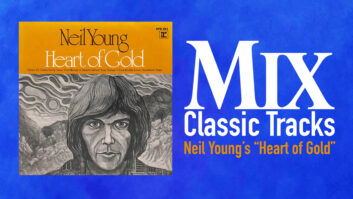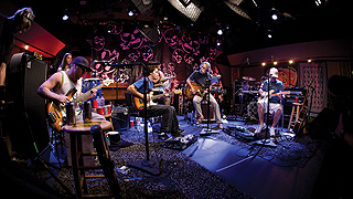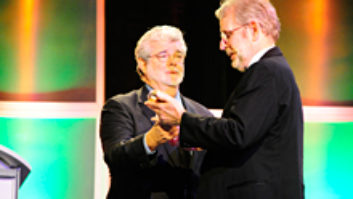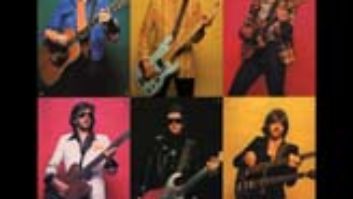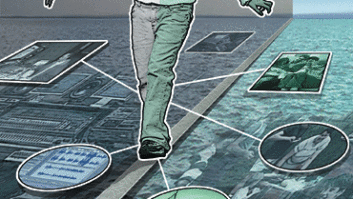REMASTERING FOR FUN AND PROFITYou know that feeling you get when you’re making the perfect car tape, when every song you add suggests the next one, and you can’t wait to pop it in and crank it up on your next road trip? Well, Bob Irwin does. He’s turned it into one of the most successful and respected careers in the remastering/reissue business.
Irwin is the guitar-player/music-seller/music-lover who put his passion and his savings into his own independent reissue label, Sundazed. In the mid-’80s, when the major labels were still stumbling around the technology needed to turn their vinyl into the new CD format, Irwin was researching unreleased material, working from original multitrack masters – creating the kind of reissues that we now know and take for granted. Sundazed’s first releases were so exceptional in their sonics and content that the majors took notice. Sony Music (then CBS Records) recruited Irwin to help launch the wonderful Legacy label.
Today, Irwin continues to operate in both spheres. He still produces nearly every release on Sundazed, working in his own lovingly designed, all-analog mastering suite, situated in his hometown of Coxsackie, N.Y. The Sundazed catalog now comprises releases from artists including Buck Owens, The Byrds, Nancy Sinatra, The Hollies, and scores of other rock and pop acts from the ’50s, ’60s and ’70s. He also produces dozens of releases for Legacy every year out of Sony Music Studios in Manhattan. Over the years, he’s worked on more than 300 releases for Legacy, including reissues and packages of Santana, Janis Joplin, and a just-completed Stevie Ray Vaughan box set. He is also part of the team producing country reissues for Legacy’s new American Milestones series.
Irwin loves his job; he takes the greatest pleasure in sharing his music discoveries with others, and so his joy is multiplied exponentially every year, as his resume and his audience grow. We spoke with him just as he wrapped up the Stevie Ray Vaughan project and was shifting gears to dig back into Sundazed’s packed schedule of fall releases.
What are you working on now?
At Sundazed, we have a lot of wonderful things on tap. It’s our crunch time right now. We’re spending a lot of time getting our year-end releases ready. Along with our flow of compact disc issues, we still do a lot of 180-gram audiophile vinyl here, and we’ve really stepped that up this Christmas season, because it’s been embraced so well. So, in addition to our CD releases, we’re coming out with projects such as the Otis Redding catalog on 180-gram LP, including Dictionary of Soul, Otis Blue and Otis and Carla Thomas’ King and Queen.
A lot of those were already reissued by Rhino on CD. Is that something you get to do, because they’re not doing vinyl versions?
That’s correct. We’ve always had a uniquely wonderful working relationship with Rhino, going back to our infancy. [Owner/founders] Richard Foos, Harold Bronson and [engineer] Bill Inglot and I have long been friends, and we’ve always worked closely. We’ve been very fortunate over the years, as Rhino has accumulated different catalogs, they’ve come to us and said, for example, “We’ve just acquired The Meters catalog,” which we’ve had wonderful success with this year, and they’d say, “We’re doing a two-CD Best Of and an individual-CD Very Best Of. Are you interested in the album catalog?” And I’d always say yes, especially if it’s a wonderful catalog like that. We continue to work well together to this day.
Is it safe, then, to say that Rhino’s work is more to create new collections or packages, and yours is getting back to original versions in new editions?
That’s correct in some respects. I think that because we are comparatively smaller and very focused on things that would tend to slip through the cracks at larger labels, those projects are often best served with a home on Sundazed, because here they’re regarded as priority releases.
What else is on the schedule for Sundazed?
Coming this fall is a Gram Parsons collection of early, unissued material that was recorded by his bandmate and friend in 1965 and 1966. It’s tentatively called Another Side of This Life – The Lost Recordings of Gram Parsons. Along with really cool folk standards, Gram is playing baby-footsteps versions of some of his songs like “November Nights” and “Brass Buttons,” the earliest known recordings of these songs. It’s a very insightful project.
Plus, we’re re-releasing Buck Owens & His Buckaroos’ complete Carnegie Hall concert from 1966 – that will be the unedited show – and the first ever Don Rich anthology. Don Rich was the guitar player and the fiddle player for Buck Owens and passed away in the early ’70s; he’s been such an influence on so many players.
Also on 180-gram vinyl, we’re coming out with a few titles from Booker T. & the MGs’ catalog, two Spirit titles, and Bob Dylan’s Bringing It All Back Home from the original mono master, which has been out of print for over 35 years, which is pretty awesome!
You’re not the producer of every single one of these reissues, are you?
Well, actually, I am. We have a staff of 15 people here at Sundazed, and nearly everyone actively participates in A&R and the creative process. There are always several plates spinning, but everything is done in-house, from the conceptualizing of the project to the actual mixing and mastering to the graphic components.
So, you have your own studio there?
Yeah, two studios built right here. The first room is an all-analog room, which has some really marvelous vintage machines and gear. We have a beautiful Michael Spitz-built ATR that we do all of our 2-track and full-track mono work on. I also recently acquired a beautiful tube-driven Presto half-inch 3-track machine from 1958, virtually unused. It’s an absolutely gorgeous centerpiece of our vintage machine collection.
What kind of monitors do you use?
In my main room, I currently have both a pair of Paradigm Studio Monitors and Genelec 1030As with a 1092A subwoofer. The Paradigms are powered by Cary SLM 100 tube mono blocks. Much of the room is tube gear.
To be honest, my work, hobby, passion all revolve around Sundazed and the joy of acquiring new projects to release and vintage gear to use. I usually say to friends that I’m not looking to buy an island, but I flip out when I get a new piece of tube gear for the studio, and it’s really true! We have just a beautiful array, the old meeting the new, ranging from vintage Pultecs, LA-2As and 3As, to new Tube-Tech, Sontec, Joemeek, API, etc., outboard gear.
I take it, then, that you prefer to work in analog.
Yes. All of my mastering work is done in the analog domain, unless something comes in on a digital source, but we prefer to work all analog as long as possible.
And the other room?
The other room is our digital suite that’s equipped with a full Sonic Solutions system, and in this room we have an array of digital gear and converters that we’re using, Apogee PSX 100s, AD122s. The monitors in the second room are Genelec 1030As, again with a subwoofer.
Did you design the rooms yourself?
Yeah. Our building was built in the mid-1800s. It’s right on the Hudson River, and by saying that, I mean you could literally throw a rock out the window and plunk it in the river! It’s a beautiful location, and the rooms upstairs are just naturally great-sounding rooms, to the point where we have a lot of people looking to work here, but the rooms already go, well, not 24 hours a day, but they easily could if I could go 24 hours a day! We just purchased another historic building just across the street. We will be putting another studio on the third floor there and use the additional space for the mountains of graphic and Web work that go on here.
Who are the other technical people on your staff?
There’s Al Quaglieri. He’s from my neck of the woods. When we first considered starting Sundazed, I took inventory of some of my closest friends and their various talents, and Al is one of the first guys I went to, because along with being a musicologist, he has wonderful studio chops. So, he and I together have worked on many, many projects. Al mastered most of The Meters releases that we did here. I also want to mention our assistant, Jayme Pieruzzi, who does a lot of Sonic editing and cleanup work.
Tell me about the Sundazed process. What happens from getting the permissions for an idea until its release?
That really varies from release to release. There are times, though not often enough, we’ll get what we refer to as a “project in a box,” when the licensor delivers all the multis and the masters to the door, along with a wide array of photos, and a great set of liner notes!
More often, we’re working five or six months ahead of ourselves on the release schedule. Here’s the breakdown: Tim Livingston and my wife Mary basically run the entire show here at Sundazed. They supervise a talented staff that includes both Efram Turchick and Stephanie Kennedy, who are in effect the general information officers and production coordinators of Sundazed. They are the conduit through which all components for a release will flow to get to the appropriate departments. They make sure that I have all the tapes here for the project when studio time is scheduled, make sure that Rich Russell, head of our design department, has all the photos and elements needed, that the liner note writer has been assigned and delivers on time, get appropriate ref’s out, etc.
Once a project idea is put down on paper, the potential licensor is contacted and, hopefully, a deal will be struck. That process can take anywhere from a day to a year. The agreement could be with an original producer, or an artist who owns their original masters, or with a major label. So, the process of getting a project onto the schedule can be rather involved. Once that’s taken place, we always like to sort through all the masters up front, so that we have the most cohesive and deepest A&R possible. We want to find out if there’s any unreleased material that might warrant being included, uncover any rare material, etc.
I’m assuming that your goal is to go back to the original masters whenever possible.
Absolutely. Al and I cut our teeth by digging around tape vaults for a good 10 years before Sundazed started, so we enjoy getting dirty and touching tape! A good example would be a project we’re working on right now for our soul series. Oscar Toney Jr., an artist from the ’60s, recorded a tremendous album for the Bell label along with a handful of wonderful singles, and because of our sleeves-rolled-up archeology, we now have the luxury of being able to work with all of the multitracks, all of the original mixdowns, session reels, and more.
Who had them?
Arista Records controls the Bell Records catalog, so the project is licensed from Arista. It’s wonderful when all the masters are delivered here, then the real fun begins when you start combing through all the multitracks to see what’s there. And in the case of Oscar Toney, we found a bevy of wonderful demos and outtakes, and because we have the vintage 1-inch 8-tracks and half-inch 4-tracks, we’re able to create some beautiful first-time stereo mixes. While we’ve never looked to be involved in revisionist history, we enjoy being able to present things in stereo when there are recordings that make for good stereo. That said, simply having a multitrack doesn’t necessarily mean that you can have championship stereo. It usually has to have been recorded with a potential stereo mix in mind. But sometimes, due to the budget constraints or time constraints at the time, there was no stereo mix done. That’s where we’ll step in.
With that in mind, tell me about your philosophy as a mastering producer. What’s more important to you: perfect fidelity, or recordings that are historically accurate?
It’s always the music first. At Sundazed, we say that we want our consumer to get a history lesson, but not know that they’re getting one. It has to be fun, for sure. We try not to be analytically dry in our packages. Everything we do is presented in an upbeat, authentic, fun way, and that means that the music definitely comes first. If the question is, do we have a track that’s an astounding performance where the fidelity is less than exceptional, we would most likely opt to use that performance, with the artist’s sanctioning, of course. The artists are involved in every release, whenever possible.
What we include also depends on the amount of material we have to work with. We just finished creating a Mighty Sam McClain package. Mighty Sam is enjoying a renewed career right now as a contemporary blues artist, but previously made some phenomenal R&B records in the ’60s. For this package, there was such a wealth of material, it was either increase the track listing, which we did do, or go to a two-CD set, which we did not do, and that meant that some things had to be left behind.
When you have, as we did, 22 or 24 stellar tracks, and your track listing is confined to 20 cuts, then we might look at the sonics of a cut or two to see if that is perhaps the track that should be left off the package. But I don’t want to make it sound like that’s what we’re shopping for, because we’d never leave an important, wonderful cut off because it was lacking in stellar fidelity. In the case of Mighty Sam, we had a wonderful bounty of performances. There were two or three demo sessions that we thought the performances were wonderful on, but on some of the cuts you could hear the limiters overloading, and we did make a couple of choices and excluded a couple of songs based on that criteria.
Have there been specific recordings for Sundazed over the years that you can single out as breakthrough successes for your label?
In the very beginning, 11 years ago, we started putting out wonderfully obscure ’60s garage groups and wild surf and hot rod material from the ’60s, and the Pulp Fiction soundtrack used five or six of our artists, so that was a great vehicle for visibility early on. Other tracks that we control are often used in soundtracks or commercials. So, what happens is, as the label grows naturally and as the catalog gets larger and more visible, that in turn attracts other artists and potential licensors to our label.
From what I understand, it was because of your meticulous and creative work with Sundazed that Sony Music became interested in you as a producer for their Legacy label.
That happened very early on. The first couple of Sundazed releases received high praise in places like Stereo Review and The New York Times, and I received a phone call from CBS Records. This was before there was a Legacy, and I began as acting as a consultant, suggesting titles that they might want to consider for re-release. That grew into a freelance production agreement as Legacy was formed.
When you produce for Legacy, you work in Sony Music Studios in Manhattan, correct?
Right. We use a variety of rooms, depending on whether we’re mixing or mastering, but because I’d say probably 60 percent of my work is mastering-related, I primarily work with an engineer whom I consider to be one of the most talented engineers at Sony Music Studios, Vic Anesini. Our relationship began when I started my first CBS project back in 1989. The studio was in a different location, it was on 52nd street, and it was very modest in comparison to what it is today. There were no live rooms; it was for mastering, and any mixing was done right in the mastering rooms.
Tell me about the studios you use today.
One of the wonderful things about working at Sony that does filter down to the Sundazed level is that at Sony Studios, there’s a wonderful, never-ending parade of cool new equipment to be auditioning and using, so we’re constantly doing shootouts and comparisons. But the basics of the room that I work in right now include a pair of Dunlavy SC-4 speakers, four Sherwood Sax hand-built tube amps, bi-amped, to power them, and a custom Sony-built mastering console. There’s also a lot of the same gear that is used at Sundazed: the Sontec EQs, a wide variety of stereo compressors and limiters, and, importantly, the same philosophy; we keep the mastering chain very, very pure. We work analog as long as we can and go to digital at the end, and it’s very project-dependent as to what A/D converter we’re going to use.
What have you been working on lately for Sony/Legacy?
The project that has occupied my past four months has been the upcoming Stevie Ray Vaughan box set. It was actually conceptualized years ago. Epic Records asked Legacy to examine Stevie’s catalog, and the first thing we did was envision a box set, but we knew that it would take months or years of planning and research to do properly. So, what we did first was to re-examine each of Stevie’s studio albums and prepare remastered, expanded editions of each.
But we still concentrated on the proposed box set; and I continued to research material with Jimmie Vaughan, Stevie’s brother; seeing what was out there in the way of unissued performances and live recordings. And the answer was a lot. Because of the vast amount of material, this wasn’t a project that could be put into focus easily. So, we worked on it for a long while, always keeping the file active and making notes.
Meanwhile, the expanded editions of Stevie’s catalog, along with the Greatest Hits Volume 2 set, called The Real Deal, that we had done were successful, so Epic asked us for finalization of the box set for this fall. Jimmie and I again worked together, enlisting some help from friends that were Stevie experts, and we assembled this wonderful three-CD plus a DVD disc, 54-track box set, 36 tunes of which have never been issued before. It’s studio material and live. Often, Jimmie and I felt that there was a certain vitality offered in a particular live performance that the studio counterpart recording might not have had.
We also wanted to showcase some of the early material that Stevie recorded before he got to Epic Records, so on Disc One, we used select tracks that were very powerful, outstanding early performances. The set opens up with a recording of Stevie with the band Paul Ray and the Cobras in 1977. This was a band he played with in Austin that was kind of like a pickup gig for him, but when they went into the studio, they let Stevie have the spotlight on a couple of tunes. He’s doing a version of The Nightcaps’ “Thunderbird,” singing lead and playing a marvelous solo; it absolutely showcases what was to come.
The disc builds through various live recordings and club gigs, demos, soundchecks, up through the Montreux Jazz Festival performance in ’82, where the audience was booing him because he was a rock ‘n’ roll guy at a jazz festival. But, that very commotion is what enhanced Stevie’s visibility for folks like Jackson Browne, David Bowie, John Hammond and others. It was after the Montreux performance that Bowie asked Stevie to perform on the Let’s Dance album and tour with him. All of this led to Stevie’s deal with Epic Records.
So, the set is organized chronologically?
The set is roughly chronological, not strictly, because there were very obvious starting and ending points that revealed themselves as we worked. “This has to kick off Disc Two,” and “this has to close Disc Three.” It’s hard to explain, but I guess it’s similar to a runner’s high. When you’re that involved in a project, if you have passion for what you’re working on, the project can often reveal itself as you go, and there are times that you can barely contain yourself as you’re putting the project together.
Those are the best kind of projects, where your heart kind of pounds while you’re putting it together, and you know what has to come next, and you know what has to follow that, and everyone in the room has the same idea at the same time. It’s like sitting in the living room with a huge stack of 45s and running for the next one before the first one is over, and saying to your friends, “You think that’s great, you’ve got to hear this!”
